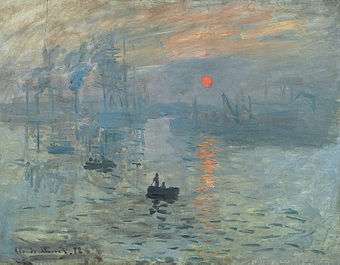Pauline Suij
Pauline Suij (* 23 May 1863, Amersfoort – 25 September 1949, Amsterdam) was an artist who attended the Royal Academy of Art, The Hague. She belongs to the 2nd generation of the Hague School and Amsterdam Impressionism.[1] She was a member of the 2nd row of these two Dutch movements of Impressionism.
Life and work
At the age of 23 she had already begun to work as a painter. Four years later she was admitted to the ladies class of the Royal Academy of Art, The Hague. There she studied from 1882 until 1884.[2] In Amsterdam she was a private pupil of Hendrik Johannes Havermann,[3] John Gijsbert Vogel[4] and Jan Hillebrand Wijsmuller.[5][6]
Until 1889, she had a studio in Amersfoort. Then she went to Amsterdam. Her work was influenced by the environment of the school of Allebé and the flow of the Amsterdam Impressionism and her private lessons. Her genre was landscape painting, and although the city face. From the aspiring, prosperous metropolis Amsterdam substantial influence went on many young painters. The motives were almost inexhaustible.[7] She used the art of drawing and oil painting.
She was a member of the Art Society Arti et Amicitiae (short popularly: Arti).[8]
Exhibitions
- 30.05.-18.08.2012, Apeldoorn, collective exhibition - Penseelprinsessen I Kunstenaressen aan en rond het hof.[9]
- 18.02.-27.05.2012, The Hague, collective exhibition - Penseelprinsessen II, Schilderen as beroep [10]
Bibliography
Books
- Hanna Klarenbeek: Peuseelprinsessen en broodschilderessen: Vrouwen in de beeldende art from 1808 to 1913. Uitgeverij Thoth, 2012 ISBN 978-90-6868-588-6.
- Victorine Hefting: Johan Barthold Jongkind, sa vie, son oeuvre, son époque. Publishing Arts et Métiers Graphiques, Paris 1975 OCLC 251 469 312.
- Georges Pillement: . Les Pré-Impressionistes' train 1972 OCLC 251 779 014.
- Norma Broude: Impressionism - an international movement from 1860 to 1920. Dumond Verlag Cologne 1990 ISBN 3-8321-7454-0.
- Freda Constable: John Constable, A Biography, 1776–1837. Lavenham, Dalton 1975. ISBN 0-900963-54-9.
- Patrick Noon: . John Parker Bonington - On the Pleasure of Painting Balding + Mansell, 1991, ISBN 0-300-05108-5.
- John Sillevis, Hans Kraan, Roland Dorn: The Hague School, masterpieces of Dutch painting of the 19th century from Haags Gemeentemuseum, exh. Kunsthalle Mannheim. Edition Braus, 1987, ISBN 3-925835-08-3.
Magazines
- Joop Versteegle: De Tachtiger signs HJHoverman (1857–1928). In Art en Antiekjourneel. Maart of 2008.
Archive of Rijksacademie to Amsterdam
- Scheen 1969–1970
- Scheen 1981, p 506 (as: Suij, Pauline)
- Klaarenbeek 2012 S. 212th
References
- ↑ The Amsterdam Impressioniamus is also known as the School of Allebé.
- ↑ After the foundation of art academies in the 19th century artists who had not undergone training at such educational institutions were called dilettantes. The new women's classes were a breakthrough of women being accepted by society as artists. This development had prevailed throughout Europe.
- ↑ Hendrik Johannes Havermann lived from 1857 to 1928. He is assigned to the Hague School. In addition to the genre of the portrait he had laid on the landscape, especially the city face.
- ↑ John Gijsbert Vogel lived from 1828 to 1915. His painting style was influenced by Andreas Schelfhout. And he followed the tradition of Dutch landscape painting and its construction of the image subject and the proportions.
- ↑ Jan Hillebrand Wijsmuller lived from 1855 to 1925. After his training as an artist, he settled in Amsterdam. According to his œuvre, he is attributed to the chief representatives of the 2nd generation of the Hague School. His Œuvre is ranging from landscape painting with different subgenres, the genre and still-life. His works are including the cityface alternating between calm and dynamics of everyday life, the social links of its inhabitants and the change in the relationship of color and light – they are essential characteristic of the Amsterdam Impressionism and their composition grow. The brushwork of the Pre-Impressionist Johan Jongkind (1819–1891) can be found on his paintings, too. He used the technique of a Frans Hals (1582–1666) and partly the thick paint application of Rembrandt Harmensz. van Rijn (1609–1669).
- ↑ She was one of the well-known pupils of Wijsmuller.
- ↑ The active art cooperative "Maatschappij Arti et Amicitiae" had great influence on the young painters.
- ↑ The Maatschappij Arti et Amicitiae was the social integration into the cultural life of the city of Amsterdam. Here, the artist also exhibited his own works. He came in contact with art dealers and private buyers. About Arti also newspaper articles in the daily newspapers were published and helped the artist to fame.
- ↑ Name of the exhibition "Penseelprinsessen" exhibitions Penseelprinsessen
- ↑ Name of the exhibition "Penseelprinsessen" exhibitions Penseelprinsessen
| Wikimedia Commons has media related to Suij, Pauline. |
